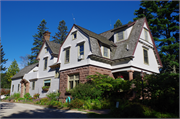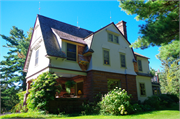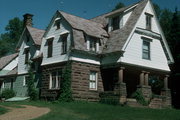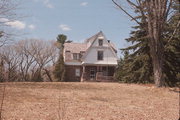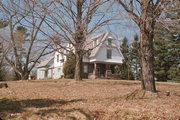Property Record
W SIDE STATE HIGHWAY 13, 0.25 MI S OF STATE FISH HATCHERY
Architecture and History Inventory
| Historic Name: | PILLAR HOUSE (SO NAMED BY ARCHITECT) |
|---|---|
| Other Name: | PINEHURST |
| Contributing: | |
| Reference Number: | 1069 |
| Location (Address): | W SIDE STATE HIGHWAY 13, 0.25 MI S OF STATE FISH HATCHERY |
|---|---|
| County: | Bayfield |
| City: | |
| Township/Village: | Bayfield |
| Unincorporated Community: | |
| Town: | 50 |
| Range: | 4 |
| Direction: | W |
| Section: | 28 |
| Quarter Section: | NE |
| Quarter/Quarter Section: | SE |
| Year Built: | 1895 |
|---|---|
| Additions: | |
| Survey Date: | 19752015 |
| Historic Use: | house |
| Architectural Style: | Queen Anne |
| Structural System: | |
| Wall Material: | Aluminum/Vinyl Siding |
| Architect: | WILLIAM LIGHTFOOT PRICE |
| Other Buildings On Site: | |
| Demolished?: | No |
| Demolished Date: |
| National/State Register Listing Name: | Not listed |
|---|---|
| National Register Listing Date: | |
| State Register Listing Date: |
| Additional Information: | A 'site file' exists for this property. It contains additional information such as correspondence, newspaper clippings, or historical information. It is a public record and may be viewed in person at the State Historical Society, Division of Historic Preservation. BROWNSTONE FIRST STORY AND RESIDED SECOND STORYPICTURESQUE ROOF WITH NUMEROUS DORMERS SEE TAX CASE FILE* Appearance unchanged in 2015. Garden house built in 2003 according to owners. Breezeway between house and summer kitchen built in 1980s. Classical breezeway entrance not original house according to owners, 2015. 2015: The Pillar House/Pinehurst is a two-and-one-half-story eclectic Shingle residence constructed in 1895. The house has an irregular footprint with a steeply-pitched front gable roof, cross-gambrel bays, and multiple shed dormers and gabled wall dormers. The house rests on a brownstone foundation and features rusticated brownstone on the first stoty. An open porch is recessed under the main front gable. The high porch walls are constructed of rusticated brownstone with four simple brownstone columns supporting the plain fascia board and gabled roof. A single one-over-one window with a wood cornice is centered in the gable above the porch. The uppermost section of the gable extends forward and is lit with a single one-over-one window. The verge board features small detailed carvings near the gable ends. The second story is sheathed with wood shingles. A prominent gambrel bay dominates the south elevation, with brownstone on the first story and wood shingles on the second. A pair of windows lights the first stoty. Two one-overone windows are present in the second stoty, while a single-light window is directly under the gable. This arrangement is repeated in the cross-gambrel bay on the north elevation. A large gabled wall dormer is located immediately west of the south-facing gambrel bay. In this area, the first story is clad in wood clapboard siding, while wood shingles remain in the second story. A small breezeway with a Classical brownstone entry connects the house with the one-and-one-half-story summer kitchen. The house and summer kitchen were connected in the 1980s. An open porch and balcony extend off of the northwest corner of the house behind the breezeway. The summer kitchen is a simple building with a brownstone foundation and wood clapboard siding. The roof of the entire structure is composed of wood shingles. The Pillar House/Pinehurst was designed by architect William Lightfoot Price for local entrepreneur, lumber baron, businessman, and politician Robinson Derling (RD.) Pike. Born in Pennsylvania in 1838, R.D. Pike was the son of early Bayfield settler Elisha Pike. In 1869, he established the RD. Pike Lumber Company which was one of Bayfield's leading industries for more than 25 years, and its docks and warehouses covered 20 blocks of Bayfield waterfront. He was president of the Bayfield and Ashland Telegraph and Telephone Company which established a telephone line from Bayfield to Ashland; he also managed the Bayfield Hydraulic Company which extended water service to the city. Pike partnered in the establishment of a stage coach line from Bayfield to Superior, and built Bayfield's first electric light system. Among Pike's many business interests, he serviced steamers with cord wood; and harvested and sold ice. He was also influential in extending rail service to Bayfield, and the Chicago, St. Paul, Minneapolis and Omaha arrived in 1883. He also opened the Bayfield Brownstone Company (AHI #4633), which supplied brownstone for the Pillar House/Pinehurst, the State Fish Hatchery (AHI # 1 068), and the Bayfield County Courthouse. Brownstone from the quarry was also shipped to large cities such as Milwaukee, Chicago, Minneapolis, and St. Paul. Finally, Pike was instrumental in the establishment of the State Fish Hatchery on Pike's Creek in Bayfield. He had operated a small fish hatchety on his property in Salmo, and the commercial fishing industty was a major economic activity in the region in the late nineteenth century. In 1896, he donated land to the State Fish Hatchety which has played an important role in stocking inland Wisconsin lakes and Lake Superior, as well as studying and eradicating invasive species such as the lamprey eel. Pike lived until 1906. The Pillar House/Pinehurst was Pike's home from 1895 until 1904, during which time he was very active in promoting and developing industries and services in the Bayfield area. |
|---|---|
| Bibliographic References: |
| Wisconsin Architecture and History Inventory, State Historic Preservation Office, Wisconsin Historical Society, Madison, Wisconsin |

